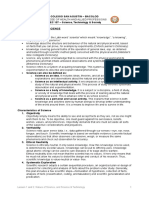0% found this document useful (0 votes)
34 views1 pageIntroduction To Science
Science is a systematic enterprise that builds and organizes knowledge in the form of testable explanations and predictions about the universe. It is a process of inquiry that involves observation, experimentation, and analysis.
Uploaded by
Max SantosCopyright
© © All Rights Reserved
We take content rights seriously. If you suspect this is your content, claim it here.
Available Formats
Download as DOCX, PDF, TXT or read online on Scribd
0% found this document useful (0 votes)
34 views1 pageIntroduction To Science
Science is a systematic enterprise that builds and organizes knowledge in the form of testable explanations and predictions about the universe. It is a process of inquiry that involves observation, experimentation, and analysis.
Uploaded by
Max SantosCopyright
© © All Rights Reserved
We take content rights seriously. If you suspect this is your content, claim it here.
Available Formats
Download as DOCX, PDF, TXT or read online on Scribd
/ 1


























































